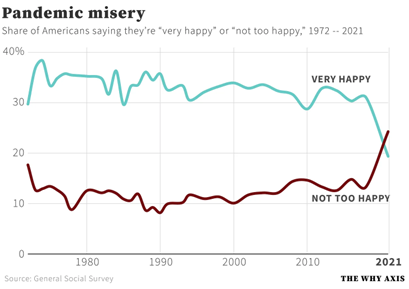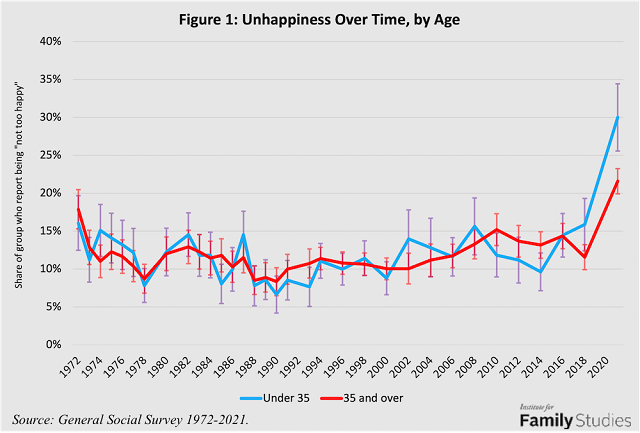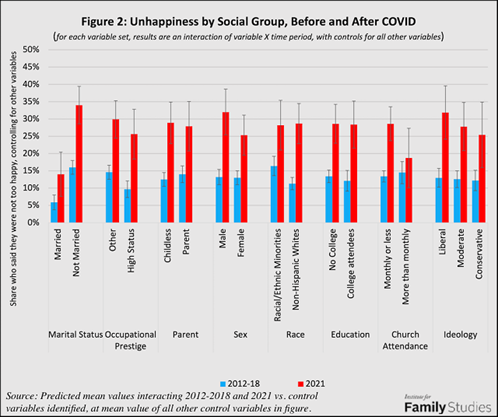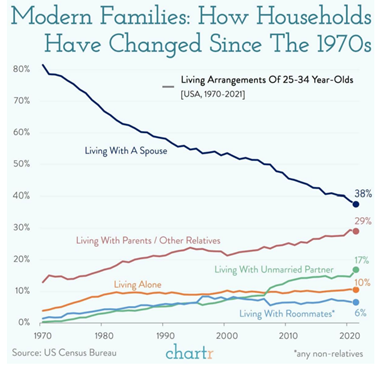The Daily Escape:

Smoke in Yosemite Valley from the nearby Oak fire – July 25, 2022 photo via Today’s California
At a family party this weekend, my daughter who owns an upscale restaurant, mentioned that while post-Covid, the restaurant is full again, the patrons are much more mean and nasty. That made Wrongo revisit the answers to the latest data on the happiness of Americans from the General Social Survey (GSS), produced by NORC, a nonpartisan research organization at the University of Chicago.
The GSS has been monitoring societal change since 1972. The last GSS survey came out in January 2022. Here’s a significant chart:

Since 1972, the GSS has asked the question: “Taken all together, how would you say things are these days–would you say that you are very happy, pretty happy, or not too happy?” As you can see above, historically the “very happy” people have outnumbered the “not too happy” group by about 3:1 for about 45 years.
But in 2021, the very-happies plummeted from 31% of the population in 2018 down to 19%, while the not-too-happies surged to 24% (the “pretty happys” remained constant at about 57%). For the first time in polling history, Americans are more likely to say they’re not happy than to say they’re very happy.
The Institute for Family Studies (IFS) has taken a look at the GSS data to see what’s driving this precipitous change. Here’s their chart of unhappiness by age:

Until 2018, fewer than 18% of Americans ages 35 and over claimed to be “not too happy”, while fewer than 16% of Americans under 35 had done so. But in 2021, unhappiness rocketed upwards for both groups, to 22% for those 35 and over, and to 30% for those under age 35.
The sharp increase for those under 35 indicates young adults are carrying a unique burden. They’re taking an extraordinarily dim view of the world and their own lives.
Among young adults, different groups had different levels of unhappiness even before Covid. For example, only 6% of married people said they were “not too happy,” versus 16% of the unmarried. The question is whether all groups saw the same spike in unhappiness. Here’s another chart from the IFS:

Unhappiness rose for every group: In each case, the red bars are higher than the blue bars.
In the GSS, social class didn’t protect people very much: Unhappiness rose about 16% for people with prestigious jobs vs. 15% for other people. People who attended college saw their unhappiness rise by 16% vs. 15% for people who didn’t attend college.
Some demographic traits did matter: Men saw their unhappiness rise 18%, vs. 12% for women. Unhappiness rose about 17% for non-Hispanic whites, vs. 12% for racial and ethnic minorities.
Religion seems to have buffered unhappiness. Among people who attended religious services at least two times per month, unhappiness rose only 4%, the smallest increase of any group.
Liberal Americans saw the largest increase in unhappiness of any group, by 19%. For moderates, it was 15%, and for conservatives, 13%. Despite what Tucker Carlson might try to make of this, the IFS says that given the sample sizes involved, those differences aren’t statistically significant.
We can blame the Covid pandemic for much of the increase in unhappiness, but we’ve also seen huge social disruption. Here’s a chart showing the percentage of 25-34 year-olds living with parents or relatives in the US:

In 1970, 11% lived with their parents, while in 2020, it was 29%. Note the decline in living with a spouse. From 80% to 38%. While people are getting married later, living alone is relatively unchanged since 1980.
This has occurred during a period when there was very little upside in real wages, and a huge increase in financial assets, which few young adults have, and in the cost of housing. This may also partially explain why young people are unhappy.
We’re about to head into a global recession and most of our politicians have zero idea how bad it will be, or how to fix it. When it comes to the midterm elections, nearly a third of voters say it doesn’t matter who wins.
Time to wake up America! We’re hoping that demography will save us before climate change slays us, or fascism overtakes us.
To help you wake up, listen to 9 year-old musical prodigy Ellen Alaverdyan perform a cover of Geddy Lee‘s iconic bassline on the classic Rush song “Tom Sawyer”:
Scroll away from the video, and she sounds like a pro. Very nice!
